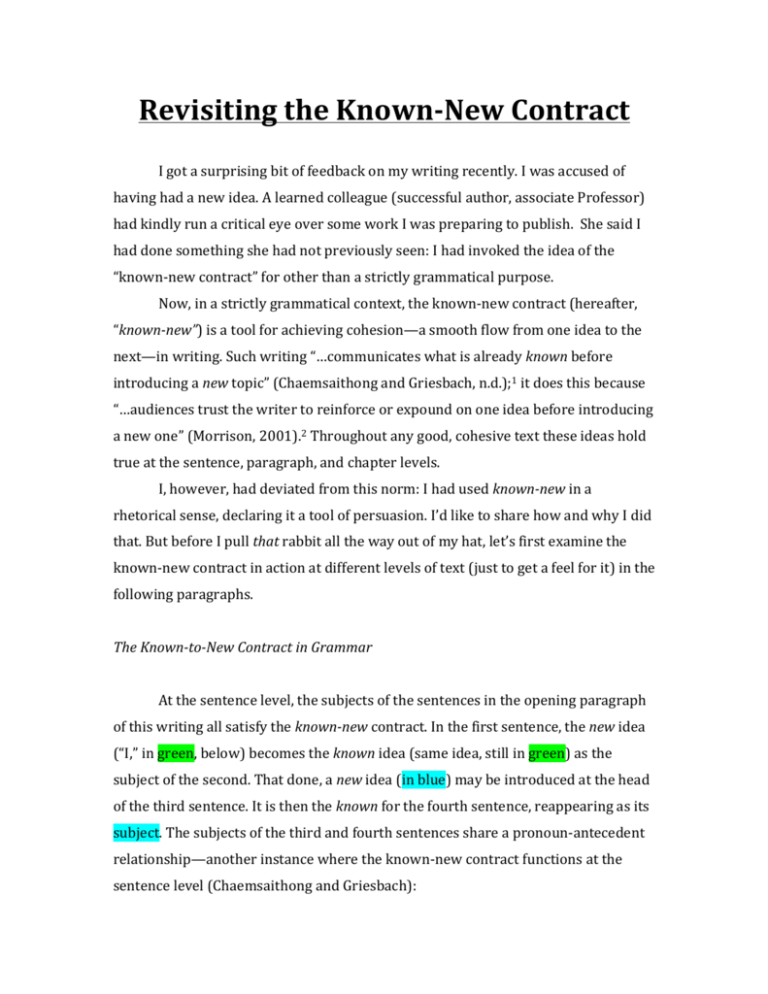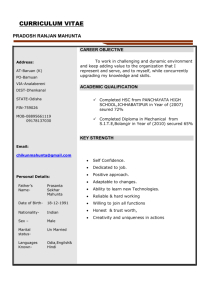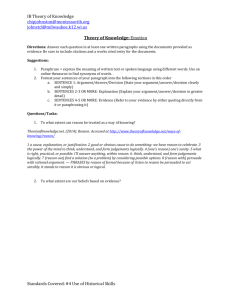Revisiting the Known
advertisement

Revisiting the Known-­‐New Contract I got a surprising bit of feedback on my writing recently. I was accused of having had a new idea. A learned colleague (successful author, associate Professor) had kindly run a critical eye over some work I was preparing to publish. She said I had done something she had not previously seen: I had invoked the idea of the “known-­‐new contract” for other than a strictly grammatical purpose. Now, in a strictly grammatical context, the known-­‐new contract (hereafter, “known-­‐new”) is a tool for achieving cohesion—a smooth flow from one idea to the next—in writing. Such writing “…communicates what is already known before introducing a new topic” (Chaemsaithong and Griesbach, n.d.);1 it does this because “…audiences trust the writer to reinforce or expound on one idea before introducing a new one” (Morrison, 2001).2 Throughout any good, cohesive text these ideas hold true at the sentence, paragraph, and chapter levels. I, however, had deviated from this norm: I had used known-­‐new in a rhetorical sense, declaring it a tool of persuasion. I’d like to share how and why I did that. But before I pull that rabbit all the way out of my hat, let’s first examine the known-­‐new contract in action at different levels of text (just to get a feel for it) in the following paragraphs. The Known-­‐to-­‐New Contract in Grammar At the sentence level, the subjects of the sentences in the opening paragraph of this writing all satisfy the known-­‐new contract. In the first sentence, the new idea (“I,” in green, below) becomes the known idea (same idea, still in green) as the subject of the second. That done, a new idea (in blue) may be introduced at the head of the third sentence. It is then the known for the fourth sentence, reappearing as its subject. The subjects of the third and fourth sentences share a pronoun-­‐antecedent relationship—another instance where the known-­‐new contract functions at the sentence level (Chaemsaithong and Griesbach): I got a surprising bit of feedback on my writing recently. I was accused of having had a new idea. A learned colleague (successful author, associate Professor) had kindly run a critical eye over some work I was preparing to publish. She said I had done something she had not previously seen: I had invoked the idea of the “known-­‐new contract” for other than a strictly grammatical purpose. In the last sentence, another new idea may now be introduced—this time, returning to the initial “I” (in green). At the paragraph level, the topics of those sentences follow known-­‐new as well, imposing order on the ideas spanning the paragraph. To illustrate, let’s color-­‐ code them (method courtesy of Morrison)—red for one idea, blue for another: I got a surprising bit of feedback on my writing recently. I was accused of having had a new idea. A learned colleague (successful author, associate Professor) had kindly run a critical eye over some work I was preparing to publish. She said I had done something she had not previously seen: I had invoked the idea of the “known-­‐new contract” for other than a strictly grammatical purpose. At this level, we actually have two known-­‐new processes working in tandem. Two ideas are introduced as new in the first two sentences. The next two sentences restate and expand on them as known ideas, in the order they were introduced (red and blue italics). This done, a new idea appears as the fusion of the two knowns (in purple)—a statement that explains and expounds on both tandem notions at once. At the chapter level, known-­‐new can manifest as metadiscourse—signal words and phrases that explicitly link sentences and paragraphs together by indicating relationships among them—such as the transition of an idea from new to known status, allowing a new idea to make its debut (Chaemsaithong and Griesbach). In this writing, metadiscourse began when the opening paragraph, initially presented to the reader as new information, recurred as an example of text demonstrating the known-­‐new relationships it had served to introduce. When used as sample text, the opening paragraph—once new information—has become known information. Once a thing is known, it is easier to process. You, the reader, were probably able to more easily follow the “play-­‐by-­‐play” breakdown of the known-­‐new relationships among the subjects of the sentences in the opening paragraph because you had read and understood that paragraph once already. It was known information. A similar dissection of a block of new text would have been more difficult to follow because you would have been less familiar with the new text. The power of the known-­‐new contract in grammar lies in the repetition on which it is founded. Say something, say it again. You can go on say something else, but then you’re required to say that again as well before you can move on to another new thing, If an idea is expressed and reinforced, it takes on a kind of legitimacy—as if the idea’s repetition followed some precedent established by its introduction. When known-­‐new is employed you’ll never hear anything less than twice. Maybe that’s all it takes. The Known-­‐to-­‐New Contract in Rhetoric At the chapter level, the known-­‐new contract can manifest as metadiscourse: …a new and interesting field of inquiry which is believed to play a vital role in organizing and producing persuasive writing, based on the norms and expectations of people involved…an important feature of communication because we need to asses the readers’ or listeners’ resources for understanding the text and their likely responses to it in order to be able to write or to speak effectively (Amiryousefi and Rasekh, 2010).3 Metadiscourse, a quality inherent in the known-­‐new contract in grammar, is also a fundamental element of persuasive writing. Audience analysis is metadiscourse; in it, one is talking about talking about something. Audience analysis has featured prominently in rhetorical theory and practice since the ancient Greeks (Silva Rhetoricae, 2011).4 Of course, the value of audience analysis lies in knowing what the audience will find persuasive. According to Stoppard (1967), “Audiences know what to expect and that is all they are prepared to believe in.”5 When an argument is founded on an understanding of what the audience is willing to believe, its chances of persuading them tend to rise. In rhetoric, known-­‐new presents arguments in the same way it arranges ideas in grammar. Start with something known—then take one logical step that reasonably arrives at something new. If done properly, the new idea will borrow at least the semblance of legitimacy for having been presented as having its basis in the known, the accepted (or asserted) truth—a direct appeal to the values and perspective of the audience, more than to the inherent value of the argument. Thus, known-­‐new can be used to demonstrate the relationship between two points along a valid line of reasoning, or in an attempt to establish such a relationship where one does not exist. Such transference of credibility from the one idea to the other could result either from causation, correlation, or some kind of corroboration between the two ideas. The effectiveness of this technique depends on the legitimacy or truthfulness of the argument itself, and/or the skill with which a talented (and presumably ethical) rhetor correlates and presents a known-­‐new line of reasoning to influence an audience. The problem (or one of the problems) with using known-­‐new as a rhetorical device is that it appears to be founded on a circular argument. It only differs from one in that instead of relying solely on supporting one statement by restating it in different or stronger terms (Baloney Detector: Circular Argument, n.d.),6 the known-­‐ new principle goes on to assert the legitimacy of the new idea by borrowing some credibility from the known idea on the basis of an implied causal, corollary, or corroborative relationship between them. A careful examination of these facts would seem to indicate that as a tool of persuasion, known-­‐new has no kind of legitimacy at all. Presumably, this conclusion could be used to argue against anything presented using known-­‐new as a rhetorical technique. The Known-­‐New Contract in Everyday Use While such grave allegations of logical impropriety are certainly true, applied known-­‐new rhetoric does serve to offer the audience an opportunity to decide for themselves whether or not an argument is acceptable, while presenting it in light of something else they already believe. This leverages Ross and Leppers’ idea of biased assimilation—that “people tend to interpret and understand new information in a way that accords with their own views” (Manjoo, 2008).7 The danger is that an unscrupulous rhetor might find it easier to understand the audience’s motivations than to find and assemble truths into a cogent argument—I hardly need to point in the direction of generations of unkept campaign-­‐trail promises as examples of such goal-­‐oriented rhetoric. So, if not solely a circular argument, known-­‐new argumentation is close to being one. I describe known-­‐new rhetoric as a “spiral argument”—each link in the chain of reasoning closely depends on the one that precedes it, borrowing legitimacy (at least in part) from their juxtaposition and/or any relationship of correlation, causation, or corroboration they may share. It is a compound error—part circular, part causation/correlation, sometimes with a non sequitur between the two. Does that make known-­‐new rhetoric an inherently baseless or illegitimate avenue of persuasion? I hope not. Most or all of the reasoning on which this writing relies has followed an application of known-­‐new method in an attempt to demonstrate it while describing it. If the method were inherently flawed and unsound, then this whole article might be speculative fiction, or even a Big Lie. While known-­‐new can certainly be used for evil, it can just as easily serve as a method to present truths with the intent of making them more palatable to the audience. In an ideal world, the “capital-­‐T Truth” of an idea would serve to persuade the audience all by itself. In the real world, it is necessary to help the audience want to believe—because if they don’t want to believe something, they probably won’t. References 1 Chaemsaithong and Griesbach. n.d. http://depts.washington.edu/engl/askbetty/cohesion.php 2 Morrison. 2001. http://www.d.umn.edu/~dmorriso/readablewriting/Coherence/known-­‐ new%20contract.html 3 Amiryousefi and Rasekh. 2010. http://ccsenet.org/journal/index.php/elt/article/download/8388/6198 4 Silva Rhetoricae 2011. http://rhetoric.byu.edu/canons/Canons.htm 5 Stoppard. 1967. Rosencrantz and Guildenstern are Dead. New York, NY: Grove Press 6 Baloney Detector. n.d. http://creationsafaris.com/crevbd.htm#circular 7 Manjoo. 2008. True Enough. Hoboken, NJ: John Wiley and Sons, Inc







